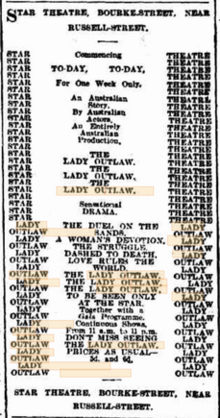The Lady Outlaw
| The Lady Outlaw | |
|---|---|
 The Age 28 Aug 1911 | |
| Directed by | Alfred Rolfe |
| Starring | Charles Villiers Alice Emslie |
Production company | |
Release date |
|
Running time | 2,500 feet[3] or over 3,000 feet[4] |
| Country | Australia |
| Languages | Silent English intertitles |
The Lady Outlaw is a 1911 Australian silent film set in Van Diemen's Land during convict days.[5]
It was also known as By His Excellency's Command or By His Excellency's Command, a Tale of a Lady Outlaw.[6][7][8]
It is considered a lost film.[9]
The film was from the Australian Photoplay Company.[10]
Plot
[edit]In the 1860s,[11] Dorothy's lover is transported to Hobart for committing a crime. She follows him there only to discover he has been assigned as a servant to a villainous land owner and has escaped to the hills, where police believe he has died.
Dorothy decides to seek revenge and leads a group of escape convicts on raids on the land owner's house. She then discovers her lover is alive and married to another woman. She decides to remain a bushranger until she gets involved in a shoot out by the sea.
After a duel between a lieutenant and her last surviving follower, she is captured by police.[12][13]
The chapter headings were:
- Arrested-for Forgery
- Transported for Life
- A Woman's Devotion
- Lieutenant Dashwood escapes
- Struggle on the Cliffs
- Dashed to Death
- A Bid-for Freedom
- A Free Pardon[14]
Cast
[edit]- Charles Villiers
- Alice Emslie
Production
[edit]The film was shot in New South Wales and featured a bushfire scene.[15]
It starred Alice Emslie, a champion horsewoman, in the lead role.[16]
Release
[edit]The film was previewed in Melbourne in August 1911.[17]
The Hobart Mercury reported that "the picture is described as one of the finest yet shown in Hobart, and the novelty of the subject should bo the means of drawing large houses."[18]
The Bulletin said the film ""interests me rather more than any other" and claimed it was meant to be based on John Batman:
There is a tradition that Batman married a woman outlaw, whom he captured in Tasmania... Can anybody explain how the outlaw legend arose? Surely it must be legend! According to the biograph, excellently got up in Sydney by Rolfe, so long associated with Dampier, the lady was of good family in England. Her lover was transported, and went through some Rufus Dawes kind of experiences in Tasmania. She went there to seek him, and was informed that he had died through the cruelty of Elton, his employer. Thereupon she takes to bushranging, as leader of a convict gang, and is just going to shoot Elton when she finds that her lover is alive, and with a wife. More agony! Here Batman comes in, under the name of Dashwood, and, after a desperate chase, captures her. Of course, it winds up with the customary cuddle of the biograph. But I don’t believe a flick of it.[19]
References
[edit]- ^ "Advertising". The Advertiser. Adelaide: National Library of Australia. 19 August 1911. p. 20. Retrieved 9 November 2014.
- ^ "Advertising". The Age. No. 17, 612. Victoria, Australia. 28 August 1911. p. 12. Retrieved 30 November 2023 – via National Library of Australia.
- ^ "Picture Shows". Williamstown Chronicle. Vic.: National Library of Australia. 27 January 1912. p. 3. Retrieved 26 February 2012.
- ^ "AMUSEMENTS". The Advertiser. Adelaide: National Library of Australia. 29 August 1912. p. 12. Retrieved 6 September 2013.
- ^ Vagg, S., & Reynaud, D. (2016). Alfred Rolfe: Forgotten pioneer Australian film director. Studies in Australasian Cinema, 10(2),184-198. doi:10.1080/17503175.2016.1170950
- ^ "Advertising". The Referee. Sydney: National Library of Australia. 8 November 1911. p. 16. Retrieved 17 May 2015.
- ^ "Advertising". Newcastle Morning Herald and Miners' Advocate. National Library of Australia. 23 October 1911. p. 8. Retrieved 17 May 2015.
- ^ "Advertising". The Examiner. Launceston, Tas.: National Library of Australia. 3 October 1911. p. 6 Edition: DAILY. Retrieved 17 May 2015.
- ^ Australian Geographical Society; Australian National Publicity Association; Australian National Travel Association (1 August 1970), "The Good Old Days of Aussie Films", Walkabout, Rex Nan Kivell Collection, 36 (8), Melbourne: Australian National Travel Association, ISSN 0043-0064, nla.obj-753803524, retrieved 30 November 2023 – via Trove
- ^ "GENERAL GOSSIP". Referee. No. 1292. New South Wales, Australia. 9 August 1911. p. 16. Retrieved 30 November 2023 – via National Library of Australia.
- ^ "WEST'S PICTURES". Bairnsdale Advertiser and Tambo and Omeo Chronicle. Vic.: National Library of Australia. 13 January 1912. p. 2 Edition: Morning. Retrieved 6 September 2013.
- ^ Andrew Pike and Ross Cooper, Australian Film 1900–1977: A Guide to Feature Film Production, Melbourne: Oxford University Press, 1998,23
- ^ "VICTORIA HALL PICTURES". Daily Post. Vol. IV, no. 215. Tasmania, Australia. 11 September 1911. p. 8. Retrieved 30 November 2023 – via National Library of Australia.
- ^ "CITIZENS' CONCERRTS". Geelong Advertiser. Vic.: National Library of Australia. 1 February 1912. p. 4. Retrieved 10 November 2014.
- ^ "Maffra Spectator". The Maffra Spectator. Vic.: National Library of Australia. 18 January 1912. p. 3. Retrieved 6 September 2013.
- ^ "OBITUARY". Newcastle Morning Herald and Miners' Advocate. NSW: National Library of Australia. 16 May 1945. p. 5. Retrieved 9 November 2014.
- ^ "GENERAL GOSSIP". The Referee. Sydney: National Library of Australia. 9 August 1911. p. 16. Retrieved 9 November 2014.
- ^ "AMUSEMENTS". The Mercury. Hobart, Tas.: National Library of Australia. 9 September 1911. p. 3. Retrieved 2 April 2015.
- ^ "PERSONAL ITEMS", The Bulletin, John Ryan Comic Collection (Specific issues)., 32 (1648), Sydney, N.S.W: John Haynes and J.F. Archibald (published 1880), 14 September 1911, ISSN 0007-4039, nla.obj-654618911, retrieved 30 November 2023 – via Trove
